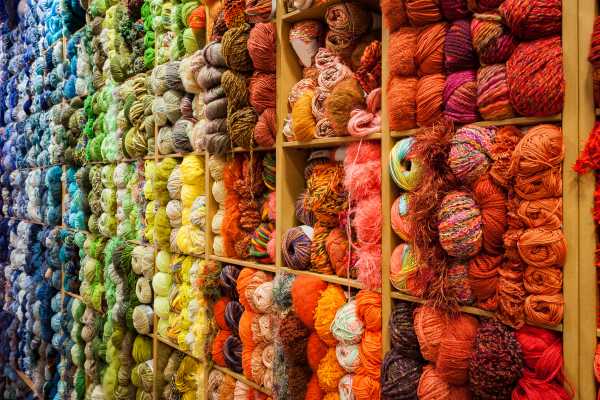 is reckoning with racism” alt=”The knitting community is reckoning with racism” />
is reckoning with racism” alt=”The knitting community is reckoning with racism” />
The knitting community is reckoning with racism
Fiber artists of color are taking to Instagram stories to call out instances of prejudice — and to try to shape a more inclusive future.
By
Jaya Saxena
Feb 25, 2019, 8:00am EST
Share
Tweet
Share
Share
The knitting community is reckoning with racism
tweet
share

Karen Templer’s Fringe Association Co. is kind of like Goop for knitting. There are tips and how-tos for navigating knitting’s trickier maneuvers. There are knit-alongs for chunky cowls and cute fingerless gloves. There’s an online store that sells the Fringe bag, which has come to be known in some circles as the Birkin of knitting bags. And there’s the blog where Templer puts her personal thoughts.
On January 7, she blogged excitedly about her upcoming trip to India. She wrote that 2019 would be her “year of color.” She said that as a child, India had fascinated her, and that when an Indian friend’s parents offered to take her with them on a trip, it was “like being offered a seat on a flight to Mars.” She spoke of her trip as if it were the biggest hurdle anyone could jump: “If I can go to India, I can do anything — I’m pretty sure.” Templer, it should be noted, is white.
As someone who is mixed-race Indian, to me, her post (though seemingly well-meaning) was like bingo for every conversation a white person has ever had with me about their “fascination” with my dad’s home country; it was just so colorful and complex and inspiring. It’s not that they were wrong, per se, just that the tone felt like they thought India only existed to be all those things for them.
The initial comments on Templer’s blog post were supportive, but quickly, knitters and fans began to criticize her tone. “Karen, I’d ask you to re-read what you wrote and think about how your words feed into a colonial/imperialist mindset toward India and other non-Western countries,” wrote commenter Alex. “Multiple times you compare the idea of going to India to the idea of going to another planet — how do you think a person from India would feel to hear that?”
Templer has since apologized for her post, writing, “It took women of color pointing this out for me to see it … which is not their responsibility, and I am thankful to them for taking the time,” and that she’d be continuing to raise visibility of people of color (and specifically black/indigenous POC) knitters and their work. (Templer declined to comment for this piece.) But her post triggered a wave of conversations about racism and prejudice in the fiber arts world, which thus far shows no signs of slowing down.
How the conversation started
Odds are if you’re in your 20s or 30s, you have at least one friend who’s gotten really into knitting in the past few years. The ancient craft never went away, but relatively recently, aided by its high Instagrammability, a heightened appreciation of DIY, and everyone’s desperate need to keep their hands busy in an anxiety-inducing world, it became more within the purview of urbane people who know how to flex online.
Social media and the internet have allowed more people than ever to share their love of fiber arts, whether it’s through the ease of exchanging patterns and tips, or just connecting with other people who share the same interests. It’s not just that it makes knitting feel cool; it’s that knitters can find community within a hobby or livelihood that’s often done in solitude.
Social media is also a source of income for many knitters and fiber artists, who use Instagram to promote their Etsy shops, to connect with customers who want commissions, or to interact with brands and blogs. It’s as much socializing as it is networking, whether that means tagging the yarn dyers and pattern makers who made your hat possible, or asking your followers what kinds of things they’d like to see available in your shop.
Social media also makes pointing out racism easier than ever. For weeks, POC knitters have used Instagram, and specifically Instagram stories, to share their observations, tag other knitters, and conduct polls about others’ experiences with racism in the community. Hundreds of people of color have shared stories of being ignored in knitting stores, having white knitters assume they were poor or complete amateurs, or flat-out saying they didn’t think black or Asian people knit.
Templer’s blog post was far from the first time anyone raised the issue of whitewashing in knitting. “I think exactly two years ago, I tried to speak about this,” said Korina Yoo, a 23-year-old Filipina immigrant of mixed heritage living in Portland, Oregon, who shares her knitting via the account @thecolormustard. Grace Anna Farrow (@astitchtowear), a 38-year-old knitter in New Mexico, agreed that she’d seen conversations happen but they didn’t seem to stick. “I feel like the conversations were happening and they just weren’t getting attention, or they were in pockets that were so separated that you could conceivably ignore them all,” she said.
The knitters I spoke to were frustrated that Templer’s blog post seemed to be the thing that made that conversation blow up. “To say that it started with Karen Templer is to give her more credit than she deserves,” said Farrow, “but to say that white women noticed it when it happened to Karen Templer is more accurate. … That’s shitty, but if that’s what it takes to get the conversation started, I have trouble spending a lot of time feeling bad about it.”
Yoo and Farrow have been two of the loudest voices in the conversation, as well as Sukrita Mahon (@su.krita) and Ocean Rose (@ocean_bythesea), among others. “We’ve had overwhelming support from all kinds of people,” said Mahon. “I really feel like we have a supportive audience that wants the community to do better and be better. It’s so encouraging. I’m daring to think that maybe we do belong.”
The conversation has certainly reached those outside the POC knitting community. “I saw [Templer’s] post mentioned in an Instagram story by one of the black knitters I follow, and I think they linked to @su.krita’s stories,” said Mark Popham, a 32-year-old white knitter in Brooklyn. “Then I started following a handful of BIPOC posting about it, and I’ve been following it since.”
And while he’d assumed that the knitting community was probably as racist as the world at large (read: very), he learned more about how he could combat that in this community. “I definitely had not done anything about what that would look like in this context — how it feels to be the only person of color in a knitting group, or see an Instagram feed with all white models, or have people say explicitly racist things to you at a knitting festival,” he said. “It shouldn’t take a person of color to point out that it’s weird to have an image of a diverse community be lily-white.”
The backlash to the conversation
The most common image of knitting is still probably an old white lady sitting in a rocking chair making a blanket (a stereotype that tends to grind modern knitters’ gears, with reason). But even though the stereotypical image has gotten younger over the years, the community is still perceived as very white. Part of that is a problem of access: Mahon points to the expense, especially if you’re buying high-quality or indie-made yarns (hand-dyed or luxurious yarn can be around $30 a skein, and depending on yardage, you’d need at least three to four skeins to make a sweater). “And it just keeps getting more and more expensive and elitist, until only other white women can keep up,” she said.
But another part is pure “marketable aesthetics,” says Yoo. “At some point, those super-blue filters came through, and then the minimalism came through, and then the not showing who you are, the cup of coffee, ball of yarn … spaces could become whitewashed without you really noticing.” The popular look was to focus on the knitting, not the person doing the knitting, which made it easier to forget what that person looked like. And sometimes, when followers were reminded, they showed their prejudice.
Rose said she noticed the whitewashing of the community when she’d post a photo of herself, or part of herself, after long stretches of only showing yarn or other images. “I just noticed the space was easier to navigate when I didn’t show who I was, because then you wouldn’t assume that I was a black person,” she said. “When I didn’t show myself, people would assume that the picture was from a white person. That’s when I knew it was really whitewashed.”
Though the conversation that Mahon, Rose, Yoo, and Farrow (among many others) have pushed forward has helped a lot of people see racism and whitewashing for what it is, there has also been pushback. The conversation has gotten some attention from the press, first in the New Yorker and later in Quillette, which called it a “witch-hunt” and involved a lot of hand-wringing over people being accused of being racist.
The backlash is “usually from white people who don’t understand why we’re ‘making it about race,’” says Mahon. “It’s generally people who either don’t think this is a problem or feel uncomfortable engaging with us. There are also POC who find this discussion uncomfortable, which I find harder to deal with. They just don’t want to rock the boat too much — but we already know where that gets us (nowhere).”
Hand-dyer and knitter Maria Tusken, who is white, posted a video on YouTube saying she spoke for the “silent majority” of knitters who didn’t think racism was a problem, that people were being “hostile … all in the name of this social justice issue.” She added that those who did were following a “one-sided belief” that was leading them to bully people who didn’t think racism was a problem. (Tusken did not respond to request for comment for this piece.)
Her video was held up as an example of the fragility of many white knitters — even if they’re not leaving explicitly racist comments, many are refusing to engage with the conversation, and appear to agree with Tusken that the real “bullies” are those who point out white privilege to begin with.
So what happens now?
Though YouTube and blog posts have been part of the conversation, a vast majority of it has happened over the more ephemeral medium of Instagram stories. Mahon, Yoo, and others have made highlight collections of the conversation, but the format makes some things difficult.
“Sometimes you really feel the limits of the platform — not being able to link to websites, having to break statements into the comments,” said Popham, “but on the other hand, I don’t think this conversation could have happened elsewhere. There just isn’t another place where you could have this community, somewhat uncensored and able to react to one another.”
Those who facilitated the conversations agreed that the temporality of Instagram stories is what let them feel free to voice their concerns. “I think Instagram stories is a little less risky,” said Rose. Your main feed is “sort of like your landing page; people will go onto your feed and they see everything there. But with stories, you can kind of go wild.”
And according to Farrow, Instagram stories replicates the way these conversations have always worked. “The fact that it connected people makes it valid,” she said. “The fact that it’s temporary doesn’t make it less valid. Most conversations are temporary and exist in the moment and then expire, but that’s how we live.”
Stories have also allowed knitters of color to retain control over the conversation. Yoo says a number of white knitters have asked that these conversations take place in person. “I think it’s just like, ‘I prefer where you can see the amount of privilege that I can exhibit and extort,’” she said. But online, everyone is closer to being on equal footing; you can’t pressure someone into following the social norms of “polite conversation.”
Talking about it is always the first step, but as to how this conversation changes things going forward, it’s still unclear. Many people have pledged, whether on Instagram or in Reddit comments, to buy more knitwear and supplies from POC sellers, and say they’ve taken to heart the stories that have been shared. “Change is happening behind the scenes, and I find that encouraging, but also, when it’s not visible, how do you know?” asks Mahon.
One way these knitters are moving forward is with Unfinished Object, a blog from Mahon, Rose, Yoo, and Farrow that aims to explore “how diversity becomes inclusion, how representation morphs into change, and how we can serve our joy while being meaningfully present in our truths — in the fibre world and beyond.” So far, Mahon has written about feeling that her local knitting community in Sydney hasn’t taken enough of a stand against racism, and the group has an FAQ on how to be a better ally.
Perhaps the biggest change is how knitters of color will use a tool like Instagram from now on. “I cannot just mindlessly scroll anymore,” said Yoo. She and others are more aware than ever of whom they follow and support in the community. But Yoo also says the most promising aspect is that they’re not the center of the conversation anymore. “We’ve been exhausted, but seeing it sparked up again, seeing new voices, new coalitions sort of forming, that was like, ‘Oh, this is great.’”
Sourse: vox.com






